 W
WA Pallas nagy lexikona was the first Hungarian encyclopedia which was not a translation from other languages. It was published by the Pallas Literary and Press Corporation between 1893 and 1897. The encyclopedia comprised 16 volumes, 150 000 articles, and it was the work of 300 authors.
 W
WThe Allgemeine Encyclopädie der Wissenschaften und Künste was a 19th-century German encyclopaedia published by Johann Samuel Ersch and Johann Gottfried Gruber, therefore also known as the "Ersch-Gruber." One of the most ambitious encyclopaedia projects ever, it remains uncompleted.
 W
WThe Austro-Hungarian Monarchy in Word and Picture or, as it is generally known, the Kronprinzenwerk, is a 24-volume encyclopedia of regional studies, initiated in 1883 by Crown Prince Rudolf of Austria-Hungary.
 W
WThe Biologia Centrali-Americana is an encyclopedia of the natural history of Mexico and Central America, privately issued in 215 parts from 1879 to 1915 by the editors Frederick DuCane Godman and Osbert Salvin, of the British Museum in London. It was begun by Alfred Maudslay publishing his first long-form description of the Archaeology at Chichen Itza.
 W
WBrehms Tierleben is a scientific reference book, first published in the 1860s by Alfred Edmund Brehm (1829–1884). It was one of the first modern popular zoological treatises. First published in German as a six volume work that was completed in 1869 it was published by the Bibliographisches Institut of Herrmann Julius Meyer with illustration directed by Robert Kretschmer. The second edition, completed in 1879 had ten volumes. It was translated into several European languages.
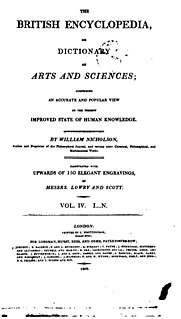 W
WThe British Encyclopedia, or Dictionary of Arts and Sciences, claimed by its publishers to be a work "Comprising an accurate and popular view of the present improved state of human knowledge", was published at London in 1809 in six octavo volumes and around 150 plates.
 W
WThe Brockhaus and Efron Encyclopedic Dictionary is a comprehensive multi-volume encyclopedia in Russian. It contains 121,240 articles, 7,800 images, and 235 maps. It was published in Imperial Russia in 1890–1907, as a joint venture of Leipzig and St Petersburg publishers. The articles were written by the prominent Russian scholars of the period, such as Dmitry Mendeleyev and Vladimir Solovyov. Reprints have appeared following the dissolution of the Soviet Union.
 W
WThe Brockhaus Enzyklopädie is a German-language encyclopedia which until 2009 was published by the F. A. Brockhaus printing house.
 W
WChambers's Encyclopaedia was founded in 1859 by William and Robert Chambers of Edinburgh and became one of the most important English language encyclopaedias of the 19th and 20th centuries, developing a reputation for accuracy and scholarliness that was reflected in other works produced by the Chambers publishing company. The encyclopaedia is no longer produced. A selection of illustrations and woodblocks used to produce the first two editions of the encyclopaedia can be seen on a digital resource hosted on the National Museums Scotland website.
 W
WChambers's Encyclopaedia was founded in 1859 by William and Robert Chambers of Edinburgh and became one of the most important English language encyclopaedias of the 19th and 20th centuries, developing a reputation for accuracy and scholarliness that was reflected in other works produced by the Chambers publishing company. The encyclopaedia is no longer produced. A selection of illustrations and woodblocks used to produce the first two editions of the encyclopaedia can be seen on a digital resource hosted on the National Museums Scotland website.
 W
WThe Complete Compendium of Universal Knowledge, Containing All You Want to Know of Language, History, Government, Business and Social Forms, and a Thousand and One Other Useful Subjects is an 1891 encyclopedia by William Ralston Balch. As its title suggests, it "sought to compile all knowledge of the universe into one digestible read". Topics covered were a smorgasbord of subjects including "how to cure stammering, how to clean and brighten our Brussels carpets, how to change our name and, of course, how to get rich... recipes ... and the fate of the apostles, how many Union Army troops died in the Civil War, and the cost of constructing a mile of railroad". It is described as "a mammoth undertaking that eventually led to a prototype for the first encyclopedias".
 W
WThe Cyclopedia of New Zealand: industrial, descriptive, historical, biographical facts, figures, illustrations was an encyclopaedia published in New Zealand between 1897 and 1908 by the Cyclopedia Company Ltd. Arthur McKee was one of the original directors of the company that published The Cyclopedia, and his business partner H. Gamble worked with him on the first volume. Six volumes were published on the people, places and organisations of provinces of New Zealand. Despite being vanity press and almost wholly restricted to white male European colonists to the exclusion of Māori, women and other minorities, the Cyclopedia is still an important historical resource. Its breadth of coverage of many small towns and social institutions were poorly covered by contemporary newspapers and other sources. The first volume, which covered Wellington, also included the colonial government, politicians, governors, and public servants. The first volume was produced in Wellington, and the remaining volumes were produced in Christchurch.Volume 1. Wellington Provincial District. Published 1897 Volume 2. Auckland Provincial District. Published 1902 Volume 3. Canterbury Provincial District. Published 1903 Volume 4. Otago and Southland Provincial Districts. Published 1905 Volume 5. Nelson, Marlborough and Westland Provincial Districts. Published 1906 Volume 6. Taranaki, Hawke's Bay and Wellington Provincial Districts. Published 1908
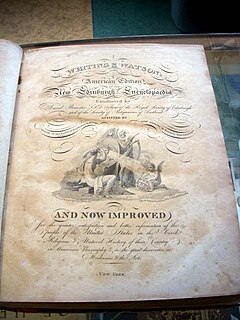 W
WThe Edinburgh Encyclopædia was an encyclopaedia in 18 volumes, printed and published by William Blackwood and edited by David Brewster between 1808 and 1830. In competition with the Edinburgh-published Encyclopædia Britannica, the Edinburgh Encyclopædia is generally considered to be strongest on scientific topics, where many of the articles were written by the editor.
 W
WJohn Wilkes was an English printer, bookseller and stationer.
 W
WThe Encyclopædia Perthensis was a publishing project around the Morison Press in Perth, Scotland undertaken in the 1790s, with the involvement of James Morison. Morison went into partnership with Colin Mitchel and Co.
 W
WThe Encyclopaedia of the Philosophical Sciences by Georg Wilhelm Friedrich Hegel, is a work that presents an abbreviated version of Hegel's systematic philosophy in its entirety, and is the only form in which Hegel ever published his entire mature philosophical system. The fact that the account is exhaustive, that the grounding structures of reality are ideal, and that the system is closed makes the Encyclopedia a statement par excellence of absolute idealism.
 W
WThe Encyclopédie méthodique par ordre des matières was published between 1782 and 1832 by the French publisher Charles Joseph Panckoucke, his son-in-law Henri Agasse, and the latter's wife, Thérèse-Charlotte Agasse. Arranged by disciplines, it was a revised and much expanded version, in roughly 210 to 216 volumes, of the alphabetically arranged Encyclopédie, edited by Denis Diderot and Jean le Rond d'Alembert. The full title was L'Encyclopédie méthodique ou par ordre de matières par une société de gens de lettres, de savants et d'artistes; précédée d'un vocabulaire universel, servant de table pour tout l'ouvrage, ornée des portraits de MM. Diderot et d'Alembert, premiers éditeurs de l'Encyclopédie.
 W
WThe English Encyclopaedia was an encyclopedia printed in London for George Kearsley in 1802.
 W
WThe Geographical Dictionary of the Kingdom of Poland and other Slavic Countries is a monumental Polish gazetteer, published 1880–1902 in Warsaw by Filip Sulimierski, Bronisław Chlebowski, Władysław Walewski and others.
 W
WThe Grand dictionnaire universel du XIXe siècle, often called the Grand Larousse du dix-neuvième, is a French encyclopedic dictionary. It was planned, directed, published, and to a substantial degree written by Pierre Larousse, though he also relied on anonymous fellow contributors and though he died in 1875, before its completion. The publication of the Grand dictionnaire universel in 15 volumes of 1500 pages extended from 1866 to 1876. Two supplements were published in 1877 and 1890.
 W
WGunsho Ruijū (群書類従) is a collection of old Japanese books on Japanese literature and history assembled by Hanawa Hokiichi (塙保己一) with the support of the Bakufu.
 W
WGyuhap chongseo is a compendium of advice for women, written by Yi Bingheogak in 1809 during the Korean Joseon Dynasty.
 W
WHardesty's Historical and Geographical Encyclopedia was a voluminous late 19th century American encyclopedia produced by H.H. Hardesty & Company, publishers, of Chicago and Toledo. A massive work with enormous amount of textual and statistical data, it went through various editions and variations throughout the 1880s, with some special editions focusing on areas of special regional significance.
 W
WThe Histoire Naturelle, générale et particulière, avec la description du Cabinet du Roi is an encyclopaedic collection of 36 large (quarto) volumes written between 1749–1804, initially by the Comte de Buffon, and continued in eight more volumes after his death by his colleagues, led by Bernard Germain de Lacépède. The books cover what was known of the "natural sciences" at the time, including what would now be called material science, physics, chemistry and technology as well as the natural history of animals.
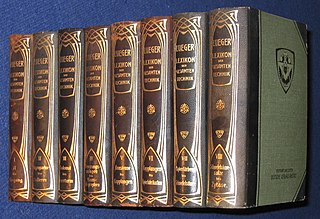 W
WThe Lexikon der gesamten Technik is an illustrated German-language encyclopedia of architectural, engineering and manufacturing technology, written by Otto Lueger and first published in 1894.
 W
WThe publication of the London Encyclopaedia, or Universal Dictionary of Science, Art, Literature and Practical Mechanics: comprising a Popular View of the Present State of Knowledge was begun by London-based bookseller and publisher Thomas Tegg in 1825. It may be found in two original editions of 22 volumes, published 1829 and 1839, as well as more recent reprints.
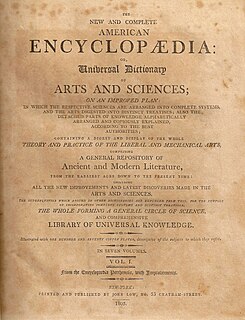 W
WLow's Encyclopædia is an early American encyclopedia, titled The New and Complete American Encyclopædia or Universal Dictionary of Arts and Sciences. It was published in New York City, from 1805 to 1811. Consisting of seven volumes quarto, it is noteworthy among America's earliest encyclopedias for having been written in the United States, as opposed to being an American reprint of a British work, as were, for examples, Dobson's Encyclopedia, the Bradford printing of Rees's Cyclopædia, Samuel A. Mitchell's American printing (1816) of the British Encyclopedia, or Dictionary of Arts and Sciences (1809), or the Birch and Small printing of the Domestic Encyclopedia.
 W
WMeyers Konversations-Lexikon or Meyers Lexikon was a major encyclopedia in the German language that existed in various editions, and by several titles, from 1839 to 1984, when it merged with the Brockhaus Enzyklopädie.
 W
WThe New American Cyclopædia was an encyclopedia created and published by D. Appleton & Company of New York in 16 volumes, which initially appeared between 1858 and 1863. Its primary editors were George Ripley and Charles Anderson Dana.
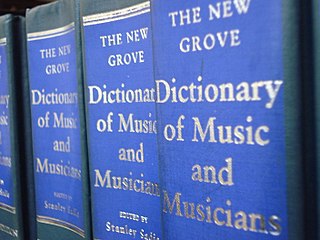 W
WThe New Grove Dictionary of Music and Musicians is an encyclopedic dictionary of music and musicians. Along with the German-language Die Musik in Geschichte und Gegenwart, it is one of the largest reference works on the history and theory of music. Earlier editions were published under the titles A Dictionary of Music and Musicians, and Grove's Dictionary of Music and Musicians; the work has gone through several editions since the 19th century and is widely used. In recent years it has been made available as an electronic resource called Grove Music Online, which is now an important part of Oxford Music Online.
 W
WThe Nouveau Larousse illustré was an illustrated French language encyclopedia published by Éditions Larousse between 1897 and 1904, in 7 volumes and a supplement. It was essentially a scaled-down version of the Grand dictionnaire universel du XIXe siècle of Pierre Larousse, but updated and written in a more neutral, scientific style under the editorship of Claude Augé (1854−1924).
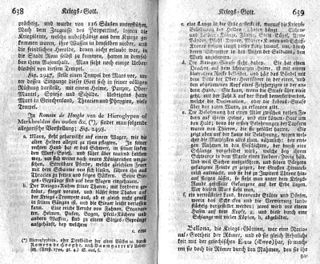 W
WThe Oekonomische Encyklopädie was a German language encyclopedia started by Johann Georg Krünitz. It appeared in 242 volumes between 1773 and 1858. Each volume has about 600-800 pages, giving a total of about 170,000 pages.
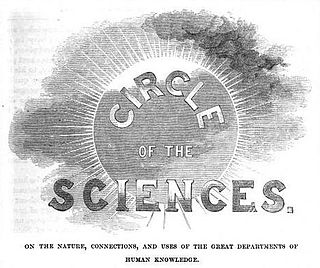 W
WOrr's Circle of the Sciences was a scientific encyclopedia of the 1850s, published in London by William Somerville Orr.
 W
WOtto's encyclopedia, published at the turn of the 20th century, is the largest encyclopedia written in the Czech language. For its scope and the quality of the writing, it is comparable to the greatest world encyclopedias of its time, such as Encyclopædia Britannica.
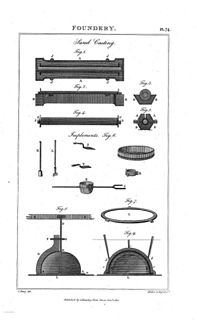 W
WPantologia is an English encyclopedia, published in 12 volumes, 8vo in 1813, with 370 plates. Its full title page was A New Cyclopedia, comprehending a complete series of Essays, Treatises and Systems, alphabetically arranged, with a general dictionary of Arts, Sciences and Words: the whole representing a distinct Survey of Human Genius, Learning and Industry, illustrated with elegant engravings; those on Natural History being from original drawings by Edwards and others, and beautifully coloured after nature ...
 W
WPears' Cyclopaedia was a one-volume encyclopaedia published in the United Kingdom. Pears' Soap launched the original Pears' Shilling Cyclopaedia in December 1897, the year of Queen Victoria's Diamond Jubilee.
 W
WThe Penny Cyclopædia published by the Society for the Diffusion of Useful Knowledge was a multi-volume encyclopedia edited by George Long and published by Charles Knight alongside the Penny Magazine. Twenty-seven volumes and three supplements were published from 1833 to 1843.
 W
WPrimer with Various Instructions (Bulgarian: Буквар с различни поучения, Bukvar s razlichni poucheniya, better known as the Fish Primer, was a Bulgarian schoolbook, the first primer printed in modern Bulgarian. It is considered by an author to be the first Bulgarian encyclopedia.
 W
WThe Realencyclopädie der classischen Altertumswissenschaft, commonly called the Pauly–Wissowa or simply RE, or PW, is a German encyclopedia of classical scholarship. With its supplements it comprises over eighty volumes.
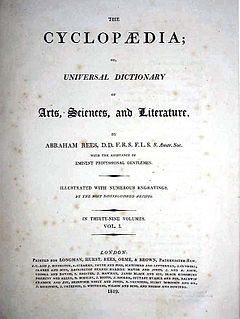 W
WRees's Cyclopædia, in full The Cyclopædia; or, Universal Dictionary of Arts, Sciences, and Literature was an important 19th-century British encyclopaedia edited by Rev. Abraham Rees (1743–1825), a Presbyterian minister and scholar who had edited previous editions of Chambers's Cyclopædia.
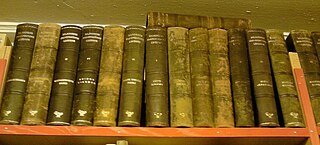 W
WSalmonsens Konversationsleksikon is a Danish encyclopedia that has been published in several editions.
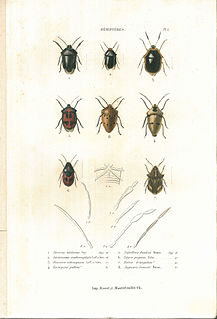 W
WLes Suites à Buffon is a French 19th-century scientific publication.
 W
WTomlinson's Cyclopaedia of Useful Arts is a multi-volume encyclopedia focusing on manufacturing, mining, and engineering. It was edited by Charles Tomlinson, a Fellow of the Royal Society, and a lecturer at King's College School, London. The original was published between 1852 and 1854 in two volumes with 40 steel engravings and 2,477 woodcuts. A supplement was published in 1862 by James S. Virtue, London and New York City.
 W
WThe Winkler Prins is a Dutch encyclopedia, founded by the Dutch poet and clergyman Anthony Winkler Prins (1817-1908) and published by Elsevier, which ran through nine editions; the first, issued in 16 volumes from 1870 to 1882, and the last, numbering 26 volumes, from 1990 to 1993. The final edition, titled De Grote Winkler Prins is one of the most comprehensive works of its kind published so far in any country, containing more than 200,000 articles and references; such prominent scholars and journalists as Frits Staal and G.B.J. Hiltermann are among the editors. Today an online subscription-based version is available.